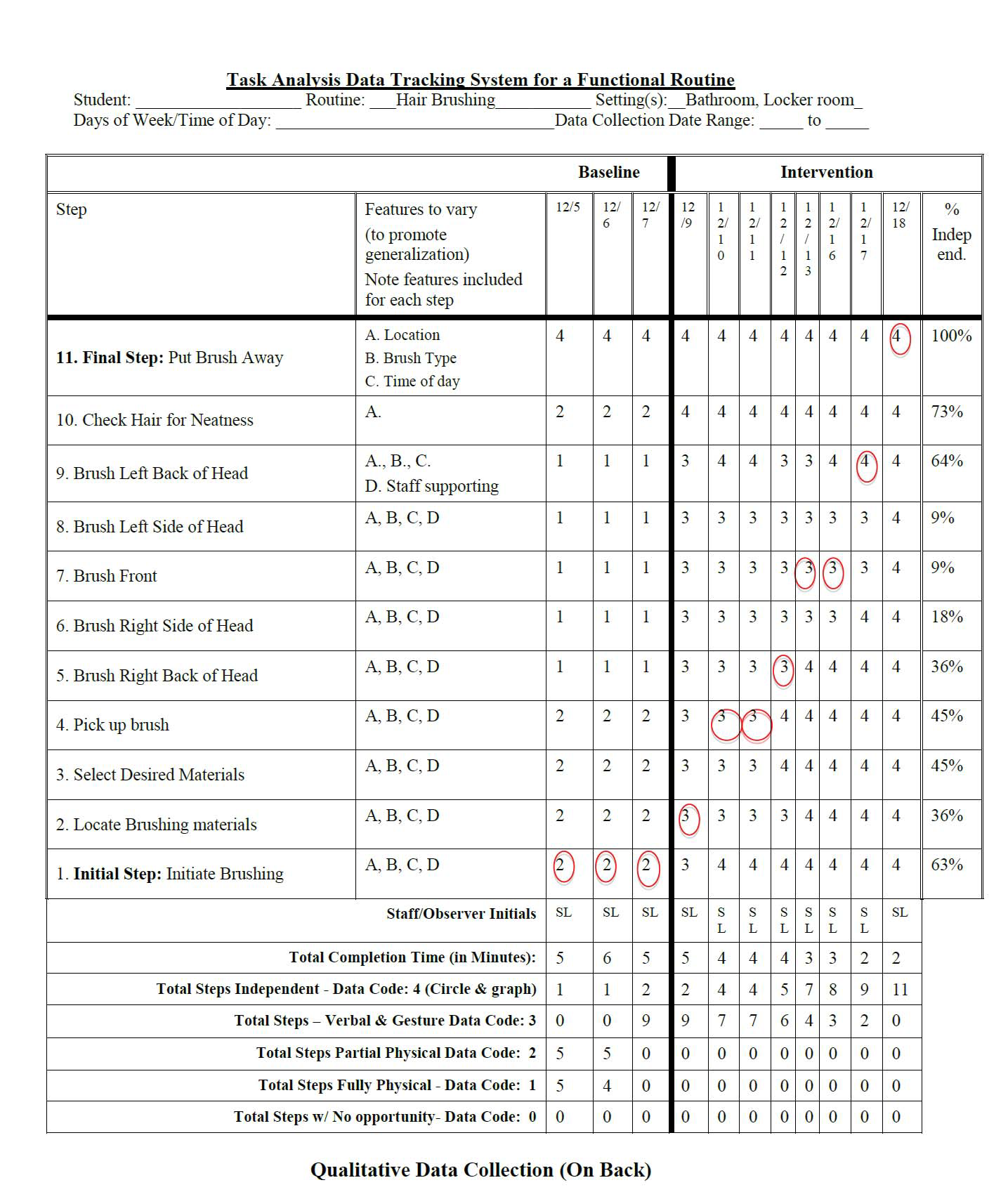Mapping Objectives to Activities in Inclusive Environments
After planning with the individual and understanding their preferences, the next step to designing an effective inclusive instructional program is to examine the instructional environments. When examining the current and future environments, identify their current goals and objectives within the context of an age-appropriate inclusive instructional setting. A common tool used for this is the Infused Skills Grid (Peak Center Inc., 1999; http://www.cde.state.co.us/cdesped/accommodationsmanual_infusedskillsgrid). The Infused Skills Grid should be completed by inserting the student’s current objectives in the horizontal rows. Then, complete the schedule of a typical student’s day (it is important that this schedule be based on a same-age peer without a disability). Using the tool, the student’s instructional team will identify when the objectives can be met within the typical instructional settings. Usually all objectives can be addressed within at least 90% of the typical schedule. A facilitator of this process, usually a special educator, can help the team think of ways the objectives can be met within inclusive environments. If an objective cannot be met within the inclusive environments, the facilitator should ask the team if the objectives should be revised to be more appropriate for a student within this setting.
Identifying Strengths and Barriers within Inclusive Settings
A daily schedule analysis (sometimes referred to as an ecological inventory; Table 1.4.1) is used to analyze the schedule and instructional environments within typical settings. Similar to the Infused Skills Grid, the first step in completing this tool is to outline the classes and environments the student would attend if he or she did not have a disability. Following the columns in the daily schedule analysis tool, specify for this class/environment: (a) the activities that all students engage in; (b) natural supports that already exist for all students; (c) target skills that the focus student needs to develop in order to participate in these activities; and (d) recommended accommodations and modifications to promote participation for the focus student. A video example of a completed daily schedule analysis with an explanation is provided in the following link: my.brainshark.com/Daily-Schedule-Analysis-Simulation-1-39562592
Breaking Down Tasks within Inclusive Environments
The daily schedule analysis provides a broad picture of instructional targets and modifications needed for an individual student. To break down specific target skills needed to be successful in inclusive environments, a task analysis should be conducted. A task analysis involves breaking down the steps of a routine or task. These individual steps are then analyzed for variations in cues and prompts to determine how to provide instruction that promotes generalization of the skills.
An example of a completed task-analysis form is provided below (Figure 1.4.1). Using this task-analysis form, identify a logical step sequence for completing the routine. Make sure to provide brief, but specific information in the step to prompt the learner. For example, instead of “student will turn the door knob to the right” state “turn the door knob.” Using this consistent language will help those implementing the plan identify verbal prompts to use with a student and help the student identify the relevant features to cue their behavior. Next, identification of stimuli that could be varied for each step should be notated in the adjacent column. Finally, data codes from 0 (no opportunity) to 1 (most intrusive level of prompting; e.g., physical prompting) to 2 (less-intrusive level of prompting; e.g., gestural prompting) to 3 (least intrusive level of prompting; e.g., verbal prompting) to 4 (independent) are used to empirically document student progress. A second sheet (Table 1.4.2) is provided to allow for anecdotal and qualitative data collection of student and teacher performance within the task. For more information and examples of task analyses, go to the National Professional Development Center on Autism Spectrum Disorders: autismpdc.fpg.unc.edu/content/task-analysis.
Table 1.4.1: Daily Schedule Analysis Template
| Domain |
School |
Activities (All students experience) |
Natural Supports (Supports available for all students) |
Target Skills (For target student during this subject; highlight priority skills) |
Possible Adaptations/Modificati ons (Consider Assistive Technology, Augmentative Communication) |
| Environments |
Grade level: |
| Sub-environments→ |
Subject 1 (e.g., homeroom, language arts) |
|
|
|
|
| Subject 2 |
|
|
|
|
| Subject 3 |
|
|
|
|
| Hallway |
|
|
|
|
| Bathroom |
|
|
|
|
| Cafeteria |
|
|
|
|
| Other |
|
|
|
|

Figure \(\PageIndex{1}\): Task Analysis Tracking Form.
Table 1.4.2: Qualitative Data Collection Form to Accompany the Task Analysis Form
Qualitative Data Collection
| |
Focus Student Performance |
Variables (Planned or unplanned) influencing student performance |
Considerations for prompting, supports or adjustments |
Instructor practices |
| Date: Baseline #1 |
|
|
|
|
| Date: Baseline #2 |
|
|
|
|
| Date: Baseline #3 |
|
|
|
|
| Date: Intervention |
|
|
|
|
| Date: Intervention |
|
|
|
|
| Date: Intervention |
|
|
|
|
| Date: Intervention |
|
|
|
|
| Date: Intervention |
|
|
|
|



